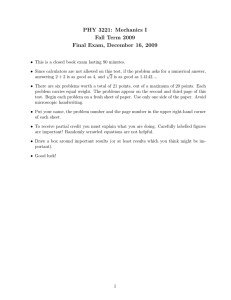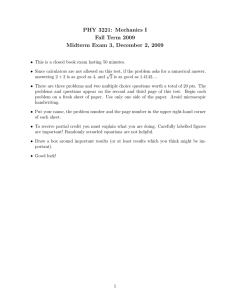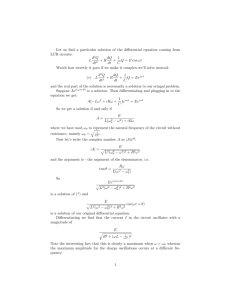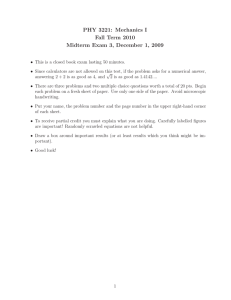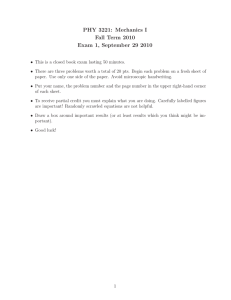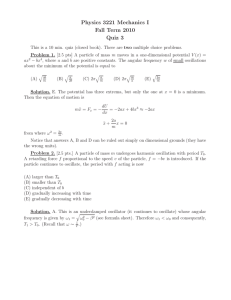PHY 3221: Mechanics I Fall Term 2010 Final Exam, December 14, 2010
advertisement
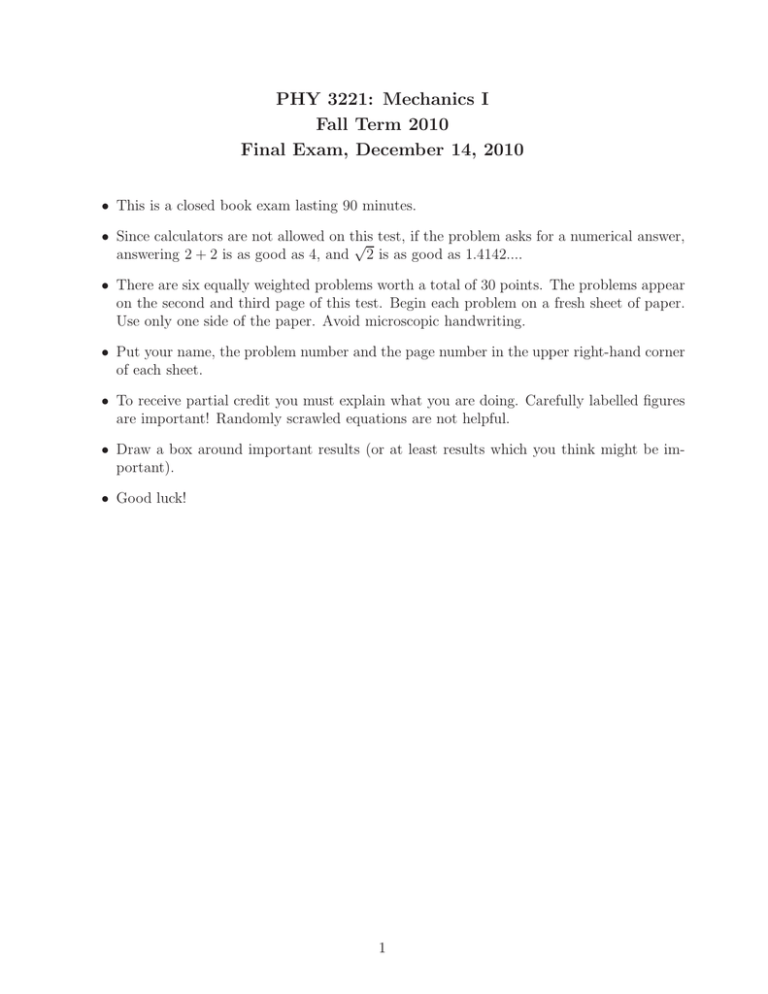
PHY 3221: Mechanics I Fall Term 2010 Final Exam, December 14, 2010 • This is a closed book exam lasting 90 minutes. • Since calculators are not allowed on this √ test, if the problem asks for a numerical answer, answering 2 + 2 is as good as 4, and 2 is as good as 1.4142.... • There are six equally weighted problems worth a total of 30 points. The problems appear on the second and third page of this test. Begin each problem on a fresh sheet of paper. Use only one side of the paper. Avoid microscopic handwriting. • Put your name, the problem number and the page number in the upper right-hand corner of each sheet. • To receive partial credit you must explain what you are doing. Carefully labelled figures are important! Randomly scrawled equations are not helpful. • Draw a box around important results (or at least results which you think might be important). • Good luck! 1 Problem 1. [5 pts] You use a rope to pull a crate across a level floor. The maximum tension that the rope can have without breaking is Tmax , and the coefficient of kinetic friction is µk . Suppose that you tug on the rope so that it makes an angle θ with the horizontal (refer to Fig. 1). Find the maximum possible mass Mmax of the crate that you can pull at constant speed without breaking the rope, and the optimal angle θopt that will allow you to do that. Hint: make sure to draw a force diagram and clearly label all forces. ~g M θ µk Figure 1: An illustration for the crate pulling problem. Problem 2. [5 pts.] Obtain the Fourier expansion of the periodic function F (t) = +1, −1, if − π/ω < t < 0, if 0 < ω < +π/ω. Problem 3: [5 pts.] A particle with mass m moves in one dimension along the x-axis in the region x > 0. It is acted upon by two forces, F~1 and F~2 . The first force F~1 is directed away from the origin, and its magnitude is linearly proportional to x as F1 (x) = C1 x , L where C1 is a fixed force constant and L is a given length scale. The second force F~2 is directed towards the origin, and has magnitude F2 (x) = C2 L3 , x3 where C2 is another fixed force constant. Find (a) the potential energy U(x); (b) the equilibrium positions (if any) and discuss whether they are stable or unstable. 2 Problem 4. [5 pts] A massless spring of relaxed length L and spring constant k hangs from the ceiling as shown in Fig. 2(a). At t = 0, a piñata of mass m is attached to the free end of the spring and released (see Fig. 2(b)). (a) Describe the subsequent motion of the piñata x(t). You can treat the piñata as a point particle and ignore air resistance. For grader’s convenience, use the coordinate system shown in Fig. 2(b). (b) Suppose that you are now blindfolded, handed a bat and spun around several times. Because of the blindfold, you cannot see the location of the piñata at any given point. At what height x (measured from the ceiling, as shown in Fig. 2(b)) should you aim the bat in order to maximize your chances of hitting the piñata? Explain your reasoning. x=0 k, L m (b) (a) x Figure 2: An illustration for the piñata on a spring problem. Problem 5. [5 pts] In the Pixar movie “Wall-E” the main character finds himself drifting away from the mothership “The Axiom” with some velocity V . Luckily, he has picked up a fire extinguisher which can eject fire-retarding foam. By switching on the fire extinguisher and spraying foam in the direction away from the ship, Wall-E can propel himself back to the ship. Let the velocity of the foam with respect to a stationary fire extinguisher be u, the mass of Wall-E be M, the mass of an empty fire extinguisher be m and the total mass of the foam be µ. Find the maximum value of V (in terms of u, M, m and µ) for which Wall-E will be able to return safely back to the Axiom. Problem 6. [5 pts.] A particle of mass m is constrained to move in one dimension under the influence of a retarding force whose magnitude is given by F = Ceαv , where C and α are positive constants. At t = 0 the particle is released from the origin (x = 0) with initial velocity ẋ = +v0 . Find the time T that it would take for the particle to stop completely. 3 Formula sheet A·(B × C) = B·(C × A) = C·(A × B) ≡ ABC A×(B × C) = (A · C)B − (A · B)C (A × B) · (C × D) = A · [B × (C × D)] = A · [(B · D)C − (B · C)D] = (A · C)(B · D) − (A · D)(B · C) (A × B) × (C × D) = [(A × B) · D] C − [(A × B) · C] D = (ABD)C − (ABC)D = (ACD)B − (BCD)A v = ṙ er + r θ̇ eθ + r sin θφ̇ eφ a = + 2ṙ φ̇ sin θ + 2r θ̇φ̇ cos θ + r θ̈ sin θ eφ v = ṙ er + r φ̇ eφ + ż ez a = r̈ − r θ̇2 − r φ̇2 sin2 θ er + 2ṙ θ̇ + r θ̈ − r φ̇2 sin θ cos θ eθ r̈ − r φ̇2 er + r φ̈ + 2ṙ φ̇ eφ + z̈ ez X k εijk εlmk = δil δjm − δim δjl X εijk εljk = 2 δil j,k X εijk εijk = 6 i,j,k Time averages over one period T : 1 T Z t+T 1 hcos ωti = T Z t+T hsin2 ωti = 2 t t 4 dt sin2 ωt = 1 2 dt cos2 ωt = 1 2 Simple harmonic oscillator: mẍ + kx = 0 x(t) = A sin(ω0 t − δ) x(t) = A cos(ω0 t − φ) s 2π = ω0 = 2πν0 = τ0 Damped oscillator: k m b ẍ + 2β ẋ + ω02 x = 0, 2β = m √ 2 2 √ 2 2 x(t) = e−βt A1 e β −ω0 t + A2 e− β −ω0 t Underdamped motion x(t) = Ae−βt cos(ω1 t − δ), ω1 = x(t) = e−βt (A1 cos ω1 t + A2 sin ω1 t) , q ω02 − β 2 ω1 = Critically damped motion q ω02 − β 2 x(t) = (A + Bt)e−βt Overdamped motion −βt x(t) = e Driven oscillator h ω2 t A1 e −ω2 t + A2 e i , ω2 = q β 2 − ω02 F0 ẍ + 2β ẋ + ω02 x = A cos ωt, A = m √ √ 2 2 − β 2 −ω02 t β −ω0 t −βt + A2 e A1 e xc (t) = e A xp (t) = q cos(ωt − δ) (ω02 − ω 2 )2 + 4ω 2β 2 −1 δ = tan q 2ωβ 2 ω0 − ω 2 ! ω02 − 2β 2 ωR Q= 2β ωR = RLC circuit VL = L Gauss’s law Z S dI dt VR = RI ~n · ~g da = −4πG 5 VC = Z V ρ dv q C Fourier series ∞ X 1 (an cos nωt + bn sin nωt) , F (t) = a0 + 2 n=1 2Z τ ω Z +π/ω F (t′ ) cos nωt′ dt′ = F (t′ ) cos nωt′ dt′ π −π/ω τ 0 ω Z +π/ω 2Zτ = F (t′ ) sin nωt′ dt′ = F (t′ ) sin nωt′ dt′ π −π/ω τ 0 an = bn Green’s function ′ G(t, t ) = 1 mω1 0, ′ e−β(t−t ) sin ω1 (t − t′ ), if t < t′ . x(t) = Z t F (t′ )G(t, t′ )dt′ −∞ Rocket motion Fext = mv̇ + uṁ 6 if t ≥ t′ ,

